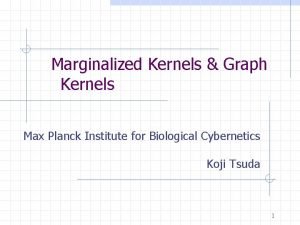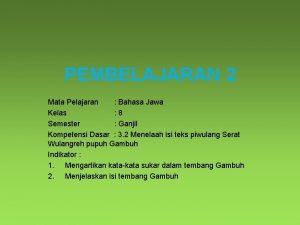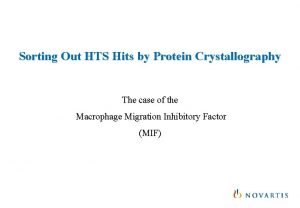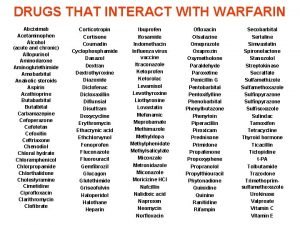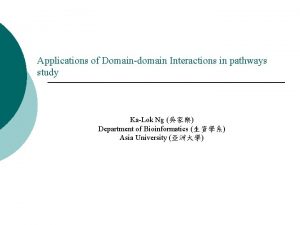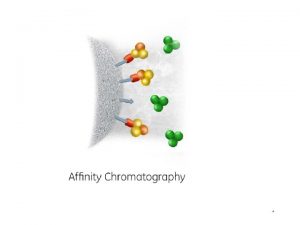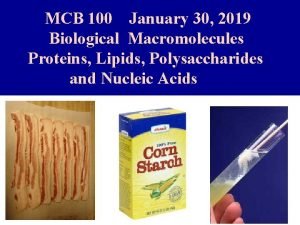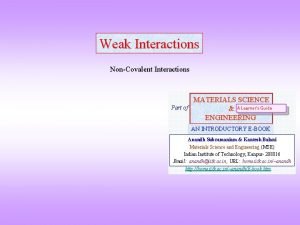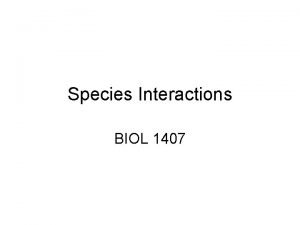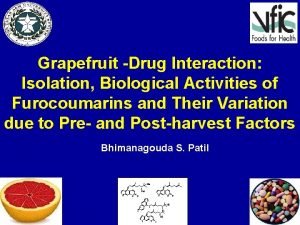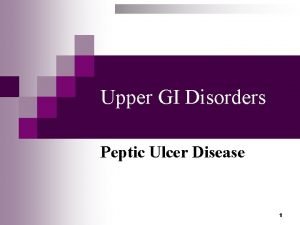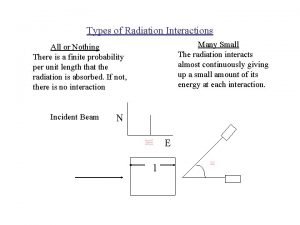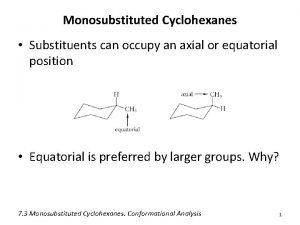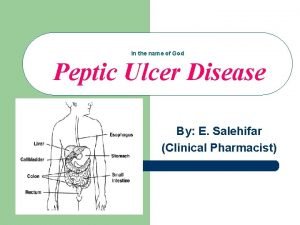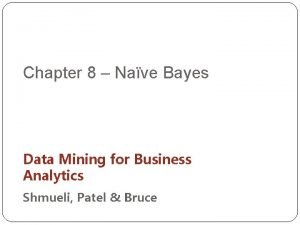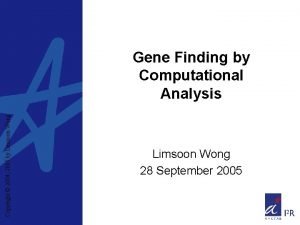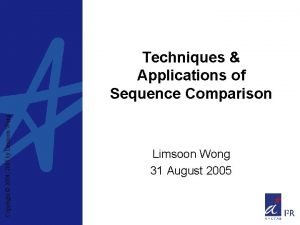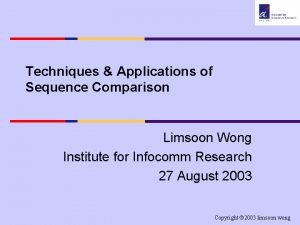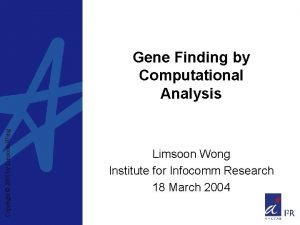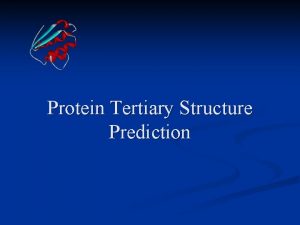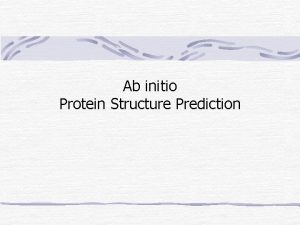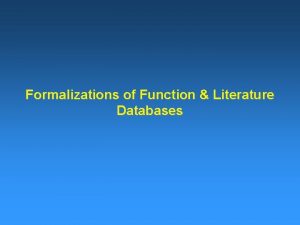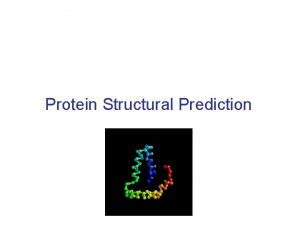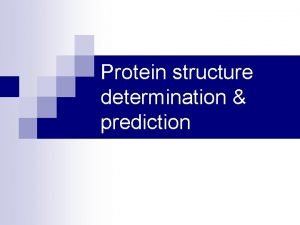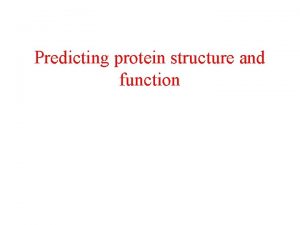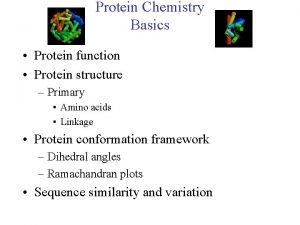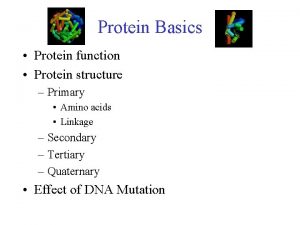Protein Function Prediction from Protein Interactions Limsoon Wong

































- Slides: 33

Protein Function Prediction from Protein Interactions Limsoon Wong NUS-KI Symp @ IMS 28 Nov 2005

PPI Extraction: The Dream • Rule-based system for processing free texts in scientific abstracts • Specialized in – extracting protein names – extracting protein -protein interactions NUS-KI Symp @ IMS, 28 Nov 2005

PIP Extraction: Challenges NUS-KI Symp @ IMS, 28 Nov 2005

Question: After we have spent so much effort dealing with this monster, what can we use the resulting interaction networks for? NUS-KI Symp @ IMS, 28 Nov 2005

Some Answers • Someone else’s work: – Guide engineering of bacteria strains to optimize production of specific metabolites – Detect common regulators or targets of differentially expressed genes, even when these are not on the microarray – And many more … • Our own work: – Improve inference of protein function even when homology information is not available NUS-KI Symp @ IMS, 28 Nov 2005

Engineering E. coli for Polyhydroxyalkanoates Production Source: Park et al. , Enzyme and Microbial Technology, 36: 579 -588, 2005 NUS-KI Symp @ IMS, 28 Nov 2005

Signaling Network Analysis for Detecting Regulators and Targets (even when these are not on the microarrays) • For example, shown here for the genes of interest (blue halo) are upstream regulators (green halo), and downstream targets (red halo). Pink oval represent genes, yellow boxes biological processes. Source: Miltenyi Biotec NUS-KI Symp @ IMS, 28 Nov 2005

Level-1 neighbour Improve inference of protein function even when homology information is not available NUS-KI Symp @ IMS 28 Nov 2005 Level-2 neighbour

Protein Function Prediction Approaches • • Sequence alignment (e. g. , BLAST) Generative domain modeling (e. g. , HMMPFAM) Discriminative approaches (e. g. , SVM-PAIRWISE) Phylogenetic profiling Subcellular co-localization (e. g. , PROTFUN) Gene expression co-relation Protein-protein interaction … NUS-KI Symp @ IMS, 28 Nov 2005

Protein Interaction Based Approaches • Neighbour counting (Schwikowski et al, 2000) • Rank function based on freq in interaction partners • Chi-square (Hishigaki et al, 2001) • Chi square statistics using expected freq of functions in interaction partners • Markov Random Fields (Deng et al, 2003; Letovsky et al, 2003) • Belief propagation exploit unannotated proteins for prediction • Simulated Annealing (Vazquez et al, 2003) • Global optimization by simulated annealing • Exploit unannotated proteins for prediction NUS-KI Symp @ IMS, 28 Nov 2005 • Clustering (Brun et al, 2003; Samanta et al, 2003) • Functional distance derived from shared interaction partners • Clusters based on functional distance represent proteins with similar functions • Functional Flow (Nabieva et al, 2004) • Assign reliability to various expt sources • Function “flows” to neighbour based on reliability of interaction and “potential”

Functional Association Thru Interactions • Direct functional association: – Interaction partners of a protein are likely to share functions w/ it – Proteins from the same pathways are likely to interact • Indirect functional association – Proteins that share interaction partners with a protein may also likely to share functions w/ it – Proteins that have common biochemical, physical properties and/or subcellular localization are likely to bind to the same proteins NUS-KI Symp @ IMS, 28 Nov 2005 Level-1 neighbour Level-2 neighbour

An illustrative Case of Indirect Functional Association? SH 3 Proteins SH 3 -Binding Proteins • Is indirect functional association plausible? • Is it found often in real interaction data? • Can it be used to improve protein function prediction from protein interaction data? NUS-KI Symp @ IMS, 28 Nov 2005

Materials • Protein interaction data from General Repository for Interaction Datasets (GRID) – Data from published large-scale interaction datasets and curated interactions from literature – 13, 830 unique and 21, 839 total interactions – Includes most interactions from the Biomolecular Interaction Network (BIND) and the Munich Information Center for Protein Sequences (MIPS) • Functional annotation (Fun. Cat 2. 0) from Comprehensive Yeast Genome Database (CYGD) at MIPS – 473 Functional Classes in hierarchical order NUS-KI Symp @ IMS, 28 Nov 2005

Validation Methods • Informative Functional Classes – Adopted from Zhou et al, 1999 – Select functional classes w/ • at least 30 members • no child functional class w/ at least 30 members • Leave-One-Out Cross Validation – Each protein with annotated function is predicted using all other proteins in the dataset NUS-KI Symp @ IMS, 28 Nov 2005

Freq of Indirect Functional Association • 59. 2% proteins in dataset share some function with level-1 neighbours YAL 012 W |1. 1. 6. 5 |1. 1. 9 YJR 091 C YMR 300 C YPL 149 W |1. 3. 16. 1 |16. 3. 3 |1. 3. 1 |14. 4 |20. 9. 13 |42. 25 |14. 7. 11 YPL 088 W YBR 293 W |2. 16 |1. 1. 9 |16. 19. 3 |42. 25 |1. 1. 3 |1. 1. 9 YBR 055 C YMR 101 C |11. 4. 3. 1 |42. 1 YDR 158 W |1. 1. 6. 5 |1. 1. 9 YBL 072 C |12. 1. 1 YBR 023 C |10. 3. 3 |32. 1. 3 |34. 11. 3. 7 |42. 1 |43. 1. 3. 5 |43. 1. 3. 9 |1. 5. 1. 3. 2 YLR 330 W |1. 5. 4 |34. 11. 3. 7 |41. 1. 1 |43. 1. 3. 5 |43. 1. 3. 9 YBL 061 C YLR 140 W • 27. 9% share some function with level-2 neighbours but share no function with level-1 neighbours YMR 047 C |11. 4. 2 |14. 4 |16. 7 |20. 1. 10 |20. 1. 21 |20. 9. 1 |1. 5. 4 |10. 3. 3 |18. 2. 1. 1 |32. 1. 3 |42. 1 |43. 1. 3. 5 |1. 5. 1. 3. 2 YKL 006 W YOR 312 C |12. 1. 1 |16. 3. 3 YPL 193 W |12. 1. 1 NUS-KI Symp @ IMS, 28 Nov 2005 YDL 081 C YDR 091 C YPL 013 C |12. 1. 1 |1. 4. 1 |12. 1. 1 |12. 4. 1 |16. 19. 3 |12. 1. 1 |42. 16

Over-Rep of Functions in Neighbours • Functional Similarity: • where Fk is the set of functions of protein k • L 1 ∩ L 2 neighbours show greatest over-rep • L 3 neighbours show no observable over-rep NUS-KI Symp @ IMS, 28 Nov 2005

Prediction Power By Majority Voting Sensitivity vs Precision 1 L 1 - L 2 - L 1 0. 9 0. 8 L 1 ∩ L 2 0. 7 Sensitivity • Remove overlaps in level-1 and level-2 neighbours to study predictive power of “level-1 only” and “level-2 only” neighbours • Sensitivity vs Precision analysis 0. 6 0. 5 0. 4 0. 3 0. 2 0. 1 0 0 • ni is no. of fn of protein i • mi is no. of fn predicted for protein i • ki is no. of fn predicted correctly for protein i NUS-KI Symp @ IMS, 28 Nov 2005 0. 1 0. 2 0. 3 0. 4 0. 5 0. 6 0. 7 Precision 0. 8 0. 9 Þ “level-2 only” neighbours performs better Þ L 1 ∩ L 2 neighbours has greatest prediction power 1

Functional Similarity Estimate: Czekanowski-Dice Distance • Functional distance between two proteins (Brun et al, 2003) • Nk is the set of interacting partners of k • X Δ Y is symmetric diff betw two sets X and Y • Greater weight given to similarity Þ Similarity can be defined as NUS-KI Symp @ IMS, 28 Nov 2005 Is this a good measure if u and v have very diff number of neighbours?

Functional Similarity Estimate: Modified Equiv Measure • Modified Equivalence measure • Nk is the set of interacting partners of k • Greater weight given to similarity Þ Rewriting this as NUS-KI Symp @ IMS, 28 Nov 2005

Correlation w/ Functional Similarity • Correlation betw functional similarity & estimates Neighbour Set CD-Distance Equiv Measure L 1 L 2 0. 205103 0. 201134 L 2 L 1 0. 122622 0. 124242 L 1 L 2 0. 491953 0. 492286 L 1 L 2 0. 224581 0. 238459 • Equiv measure slightly better in correlation w/ similarity for L 1 & L 2 neighbours NUS-KI Symp @ IMS, 28 Nov 2005

Use L 1 & L 2 Neighbours for Prediction • Weighted Average – Over-rep of functions in L 1 and L 2 neighbours – Each observation of L 1 or L 2 neighbour is summed • • S(u, v) is equiv measure for u and v, (k, x) = 1 if k has function x, 0 otherwise Nk is the set of interacting partners of k x is freq of function x in the dataset NUS-KI Symp @ IMS, 28 Nov 2005

Performance Evaluation • LOOCV comparison with Neighbour Counting, Chi-Square, PRODISTIN Informative FCs 1 NC 0. 9 Chi² 0. 8 PRODISTIN Sensitivity 0. 7 Weighted Avg 0. 6 0. 5 0. 4 0. 3 0. 2 0. 1 0 0 0. 1 NUS-KI Symp @ IMS, 28 Nov 2005 0. 2 0. 3 0. 4 0. 5 0. 6 Precision 0. 7 0. 8 0. 9 1

Performance Evaluation • Dataset from Deng et al, 2003 – Gene Ontology (GO) Annotations – MIPS interaction dataset • Comparison w/ Neighbour Counting, Chi-Square, PRODISTIN, Markov Random Field, Functional. Flow Cellular Role Biochemical Function NC Chi² PRODISTIN MRF Functional. Flow Weighted Avg 0. 7 NC Chi² PRODISTIN MRF Functional. Flow Weighted Avg 0. 8 0. 7 0. 6 0. 5 0. 4 0. 9 0. 8 0. 7 Sensitivity 0. 8 1 0. 9 Sensitivity Sub. Cellular Location 1 1 0. 6 0. 5 0. 4 0. 6 0. 4 0. 3 0. 2 0. 1 0 0. 1 0. 2 0. 3 0. 4 0. 5 0. 6 0. 7 0. 8 0. 9 Precision 1 NUS-KI Symp @ IMS, 28 Nov 2005 NC Chi² PRODISTIN MRF Functional. Flow Weighted Avg 0. 5 0 0 0. 1 0. 2 0. 3 0. 4 0. 5 0. 6 Precision 0. 7 0. 8 0. 9 1

Performance Evaluation • Correct Predictions made on at least 1 function vs Number of predictions made per protein Correct Predictions vs Predictions Made - Cellular Role Correct Predictions vs Predictions Made - Sub. Cellular Location Correct Predictictions vs Predictions Made - Biochemical Function 1 0. 9 0. 8 0. 7 0. 6 Fraction 1 0. 5 0. 4 NC Chi² PRODISTIN Functional. Flow Weighted Avg 0. 3 0. 2 0. 1 0 2 3 4 5 6 7 Predictions 8 9 10 NUS-KI Symp @ IMS, 28 Nov 2005 0. 4 0. 3 NC Chi² PRODISTIN Functional. Flow Weighted Avg 0. 2 0. 1 0 0 1 0. 5 1 2 3 4 5 6 7 Predictions 8 9 10 1 2 3 4 6 7 5 Predictions 8 9 10

Reliability of Expt Sources • Diff Expt Sources have diff reliabilities – Assign reliability to an interaction based on its expt sources (Nabieva et al, 2004) • Reliability betw u and v computed by: Source Reliability Affinity Chromatography 0. 823077 Affinity Precipitation 0. 455904 Biochemical Assay 0. 666667 Dosage Lethality 0. 5 Purified Complex 0. 891473 Reconstituted Complex 0. 5 • ri is reliability of expt source i, • Eu, v is the set of expt sources in which interaction betw u and v is observed NUS-KI Symp @ IMS, 28 Nov 2005 Synthetic Lethality 0. 37386 Synthetic Rescue 1 Two Hybrid 0. 265407

Integrating Reliability • Take reliability into consideration when computing Equiv Measure: • Nk is the set of interacting partners of k • ru, w is reliability weight of interaction betw u and v Þ Rewriting NUS-KI Symp @ IMS, 28 Nov 2005

Integrating Reliability • Equiv measure shows improved correlation w/ functional similarity when reliability of interactions is considered: Neighbour Set CD-Distance Equiv Measure L 1 L 2 0. 205103 0. 201134 0. 288761 L 2 L 1 0. 122622 0. 124242 0. 259172 L 1 L 2 0. 491953 0. 492286 0. 528461 L 1 L 2 0. 224581 0. 238459 0. 345336 NUS-KI Symp @ IMS, 28 Nov 2005 Equiv Measure w/ Reliability

Performance Evaluation • Prediction performance improves after incorporation of interaction reliability Informative FCs 1 NC Chi² PRODISTIN Weighted Avg R 0. 9 0. 8 Sensitivity 0. 7 0. 6 0. 5 0. 4 0. 3 0. 2 0. 1 0 0 0. 1 0. 2 0. 3 0. 4 0. 5 0. 6 0. 7 0. 8 0. 9 Precision NUS-KI Symp @ IMS, 28 Nov 2005 1

Incorporating Other Info Sources • PPI Interaction Data – General Rep of Interaction Data – 17815 Unique Pairs, 4914 Proteins – Reliability: 0. 366 (Based on fraction with known functional similarity) • Sequence Similarity – Smithwaterman betw seq of all proteins – For each seq, among all SW scores w/ all other seq, extract seq w/ SW score >= 3 standard deviations from mean – 32028 Unique Pairs, 6766 Proteins – Reliability: 0. 659 • Gene Expression – – Spellman w/ 77 timepoints Extract all pairs w/ Pearson’s > 0. 7 11586 Unique Pairs, 2082 Proteins Reliability: 0. 354 NUS-KI Symp @ IMS, 28 Nov 2005

Conclusions • Indirect functional association is plausible • It is found often in real interaction data • It can be used to improve protein function prediction from protein interaction data • It should be possible to incorporate interaction networks extracted by literature in the inference process within our framework for good benefit NUS-KI Symp @ IMS, 28 Nov 2005

Acknowledgements • Hon Nian Chua • Wing Kin Sung NUS-KI Symp @ IMS, 28 Nov 2005

References • • • Breitkreutz, B. J. , Stark, C. and Tyers, N. (2003) The GRID: The General Repository for Interaction Datasets. Genome Biology, 4: R 23 Brun, C. , Chevenet, F. , Martin, D. , Wojcik, J. , Guenoche, A. , Jacq, B. (2003) Functional classification of proteins for the prediction of cellular function from a protein-protein interaction network. Genome Biol. 5(1): R 6 Deng, M. , Zhang, K. , Mehta, S. Chen, T. and Sun, F. Z. (2003) Prediction of protein function using protein-protein interaction data. J. Comp. Biol. 10(6): 947 -960 Hishigaki, H. , Nakai, K. , Ono, T. , Tanigami, A. , and Takagi, T. (2001) Assessment of prediction accuracy of protein function from protein interaction data, Yeast, 18(6): 523 -531 Lanckriet, G. R. G. , Deng, M. , Cristianini, , N. , Jordan, M. I. and Noble, W. S. (2004) Kernel-based data fusion and its application to protein function prediction in yeast. Proc. Pacific Symposium on Biocomputing 2004. pp. 300 -311. Letovsky, S. and Kasif, S. (2003) Predicting protein function from protein/protein interaction data: a probabilistic approach. Bioinformatics. 19(Suppl. 1): i 197–i 204 NUS-KI Symp @ IMS, 28 Nov 2005

References • • • Ruepp A. , Zollner A. , Maier D. , Albermann K. , Hani J. , Mokrejs M. , Tetko I. , Guldener U. , Mannhaupt G. , Munsterkotter M. , Mewes H. W. (2004) The Fun. Cat, a functional annotation scheme for systematic classification of proteins from whole genomes. Nucleic Acids Res. 14: 32(18): 5539 -45 Samanta, M. P. , Liang, S. (2003) Predicting protein functions from redundancies in large-scale protein interaction networks. Proc Natl. Acad. Sci. U S A. 100(22): 12579 -83 Schwikowski, B. , Uetz, P. and Fields, S. (2000) A network of interacting proteins in yeast. Nature Biotechnology 18(12): 1257 -1261 Titz B. , Schlesner M. and Uetz P. (2004) What do we learn from highthroughput protein interaction data? Expert Rev. Proteomics 1(1): 111– 121 Vazquez, A. , Flammi, A. , Maritan, A. and Vespignani, A. (2003) Global protein function prediction from protein-protein interaction networks. Nature Biotechnology. 21(6): 697 -670 Zhou, X. , Kao, M. C. , Wong, W. H. (2002) Transitive functional annotation by shortest-path analysis of gene expression data. Proc. Natl. Acad. Sci. U S A. 99(20): 12783 -88 NUS-KI Symp @ IMS, 28 Nov 2005
 Koji tsuda
Koji tsuda Aja nganti kebanjur
Aja nganti kebanjur Protein binding interactions
Protein binding interactions Dicloxaxillin
Dicloxaxillin Protein binding interactions
Protein binding interactions Protein binding interactions
Protein binding interactions Dna-protein interactions
Dna-protein interactions Protein pump vs protein channel
Protein pump vs protein channel Protein-protein docking
Protein-protein docking Noncovalent interactions
Noncovalent interactions Congress formal and informal powers
Congress formal and informal powers 5 types of symbiosis
5 types of symbiosis Parasitism
Parasitism Qualitative and quantitative research
Qualitative and quantitative research Sertraline interactions
Sertraline interactions Lesson 2 activity 45 macroeconomics
Lesson 2 activity 45 macroeconomics The properties and interactions of magnets
The properties and interactions of magnets Grapefruit-drug interactions chart
Grapefruit-drug interactions chart Interactions within ecosystems grade 7
Interactions within ecosystems grade 7 Abiotic factor
Abiotic factor Sphere interactions
Sphere interactions Section 20-1 review species interactions
Section 20-1 review species interactions Photosynthesis is important to animals because flocabulary
Photosynthesis is important to animals because flocabulary Chapter 6 lesson 1 habitats niches and species interactions
Chapter 6 lesson 1 habitats niches and species interactions Moa of h2 antagonist
Moa of h2 antagonist Types of interactions
Types of interactions Circulatory system interactions with other systems
Circulatory system interactions with other systems Architecture
Architecture Axial substituents
Axial substituents Diazepam cyp450
Diazepam cyp450 What are the factors of communication
What are the factors of communication Symbiosis and species interactions keystone webquest
Symbiosis and species interactions keystone webquest Mouth function in digestion
Mouth function in digestion Naive bayes pays attention to complex interactions and
Naive bayes pays attention to complex interactions and
